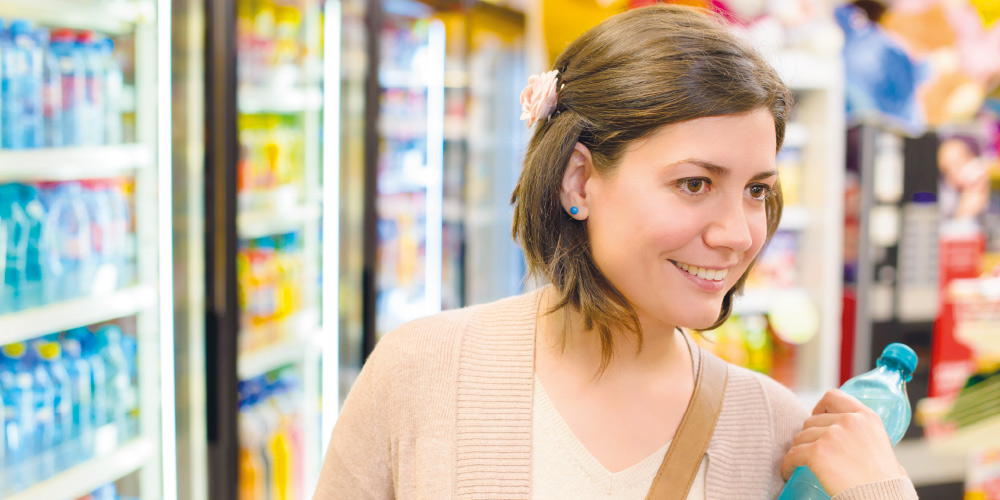Deposit return schemes, a soft drinks levy and changing customer lifestyles are changing the way soft drinks are consumed. BetterRetailing looks at the five things you need to know.
What the soft drinks tax means to you
Despite being heavily criticised by suppliers, retailers and consumers when it was announced, the soft drinks levy is now being seen as an opportunity the industry.
The biggest trend in soft drinks is the growth of no- or low-sugar drinks and consumers that buy from this segment tend to spend more overall in store.
The new legislation therefore presents a massive opportunity for retailers to make healthier options a key part of their store and drive profits.
The impending tax has driven suppliers to reformulate their products or launch low-sugar flavours. Coca-Cola European Partners (CCEP) has introduced 29 new drinks with reduced sugar or calories since 2015 and Britvic is aiming to bring 95% of its range under the sugar
levy threshold.
The shift towards lower-sugar options is a gradual process, so you need to constantly monitor your EPoS data to see where your sales are growing. Amy Burgess, CCEP trade communications manager, says: “Retailers should constantly review their soft drinks range as manufacturers introduce lighter options to meet consumer demand.”
If you have regular shoppers that buy the same brands from you each time, you need to communicate any changes to them.
Simon Gray, Boost managing director, says: “While some brands will choose, or have chosen, to revise their recipes to avoid the sugar tax, others may increase their price as the levy comes in. It is important for retailers to stay informed of these changes to best advise their customers.”
You can no longer shy away from no-sugar drinks. The market is shifting, the demand is evident and the supplier investment keeps coming.
James Logan, commercial director at Refresco, which has brands like Just Juice and Del Monte, says low sugar is no longer the exception, it is the new norm. “It is likely that going forward into 2018 and beyond that there will be limited high-sugar drinks within the market. The majority will be low- or mid-sugar levels, 5g and lower per 100ml,”
he adds.
The impact of a deposit return scheme
In May, it emerged that Scottish Parliament was investigating whether to introduce a deposit return scheme for bottles and cans in shops.
The scheme would mean that consumers would pay a levy on drinks which a store would then pay back to them once they returned the empty containers.
The announcement divided the industry, with groups such as the NFRN, Keep Britain Tidy and CCEP saying it would encourage recycling, while the Scottish Grocers Federation and Association of Convenience Stores slammed the proposal as being unfair to independent retailers.
At the Conservative Party Conference earlier this month, Environment Secretary Michael Gove announced plans to roll out a deposit return scheme in England.
Since the announcement, Retail Express spoke to trade bodies from countries where deposit return schemes have been introduced to find out the effect it could have here.
Concern over hygiene issues, lost business and limited space were among the issues raised on the front page of Retail Express’s October 3 issue.
But there were positives. Karin Brynell, managing director of Sweden’s grocery trade body Svensk Dagligvaruhandel told Retail Express that the deposit return scheme drives the association that convenience stores have with soft drinks and helps consumers recycle
in an easy way.
Consumer awareness about the scheme is relatively low right now, but the likelihood is that this scheme will become a reality.
If you can get shoppers to associate your store with recycling, you can make it a feature of your shop and get more people through the door.
Give space to growing areas
If you are going to cater to consumer demand for low-sugar drinks, you need to make sure you are dedicating enough space to these areas on
your shelves.
Mark Sterratt, Lucozade Ribena Suntory market, strategy & planning director, says: “Low-sugar drinks now claim a 30% share but in independent convenience stores only 21% of soft drinks are low sugar.”
The first step is to ensure you are offering a low-sugar version of your most popular brands, but also ensure that you are stocking
enough formats.
CCEP’s Amy Burgess says: “Offering a wide choice of different products, including a range of flavours and pack formats, is the key to making the most of soft drink sales.”
Pay attention to the marketing behind these drinks. The way health benefits are communicated to consumers is crucial.
“No-added-sugar drinks represents 19% of the soft drinks market by volume, growing year on year by 13%. Whereas those drinks marketed as diet or low sugar account for 12% of the market and are declining by 1.4% year on year,” says Refresco’s
James Logan.
Bottled water is perhaps the biggest success story of the low-sugar movement. The segment has grown by 14% within convenience stores in the
past year.
“There is opportunity to develop further. The plain bottled water category is set to see further growth in coming years, hitting volumes of 4.6 billion litres by 2021,” says Carol Saunders, Highland Spring Group head of
customer marketing.
Look at your fixture critically and see if there are areas of low-sugar that are missing or could be given more space.
Merchandising is key
Once you have planned out your range, the final step for ensuring that you become a destination for low-sugar drinks is to merchandise them in a way that captures your
shoppers’ attention.
The fixture needs to be easy to shop and demonstrate the choice you offer. Burgess says: “Stock soft drinks like Coca-Cola alongside calorie-free equivalents like Coca-Cola Zero Sugar and Diet Coke.”
Bottled water signals to shoppers a healthier choice, so these should be the first products that they see as they approach the fixture.
Highland Spring Group’s Carol Saunders says: “Position still and sparkling water lines in the bottom right or left hand side of the chiller depending on the direction of traffic flow.”
The shift in consumer concerns is not just limited to sugar. Your shoppers are looking for an all-round healthier lifestyle with a balance of treats. The stores that can help them do this are the ones that will thrive.
Refresco’s James Logan says: “The spotlight is now focusing on calories not just sugar content so retailers should look at positioning specific products as healthy rather than just low sugar or sugar free.”
The soft drinks levy and consumer trends are creating a perfect storm for success for shops that can adapt.
Retailer Views
 “We’ve gradually introduced healthier, lower sugar and sugar-free lines. We found at the start, drinks like Ribena and Vimto sold slowly but steadily, and sales have increased recently. Sales are still not on par with the original versions, but they earn their place in the chiller. As we look to the introduction of the soft drinks levy, it’ll be interesting to see what happens to the price of full-sugar drinks.”
“We’ve gradually introduced healthier, lower sugar and sugar-free lines. We found at the start, drinks like Ribena and Vimto sold slowly but steadily, and sales have increased recently. Sales are still not on par with the original versions, but they earn their place in the chiller. As we look to the introduction of the soft drinks levy, it’ll be interesting to see what happens to the price of full-sugar drinks.”
Ian Handley
Handley’s Go Local in Sandiway, Cheshire
 “We’re still trying to educate customers because they don’t realise the effect it’ll have on them. We’ve got two primary schools near us where the teachers go through children’s lunchboxes and they’re not even allowed to take flavoured water. The schools are trying to educate the children. We have noticed a lot more people buying diet drinks and they are going into detox drinks. I think we need to educate to shoppers, but you can’t dictate what people buy, you’ve got to give them the choice.”
“We’re still trying to educate customers because they don’t realise the effect it’ll have on them. We’ve got two primary schools near us where the teachers go through children’s lunchboxes and they’re not even allowed to take flavoured water. The schools are trying to educate the children. We have noticed a lot more people buying diet drinks and they are going into detox drinks. I think we need to educate to shoppers, but you can’t dictate what people buy, you’ve got to give them the choice.”
Anita Nye
Eldred Drive Stores, Orpington, south London
 “You need to have the range first so you can educate your shoppers. We obey a planogram as a One Stop so we already have a sugar-free variety for every drink, but a lot of customers will ask what they are and then we’ll discuss it with them. There’s not much in consumer press about the sugar tax, so I’d really like to see more information from the Government. We’ve got to become experts on it as well.”
“You need to have the range first so you can educate your shoppers. We obey a planogram as a One Stop so we already have a sugar-free variety for every drink, but a lot of customers will ask what they are and then we’ll discuss it with them. There’s not much in consumer press about the sugar tax, so I’d really like to see more information from the Government. We’ve got to become experts on it as well.”
Aman Uppal
One Stop Mount Nod, Coventry





Comments
This article doesn't have any comments yet, be the first!